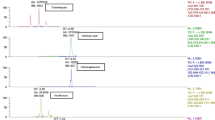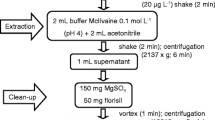Abstract
Antibiotics are often used in bee-keeping to control European and American foulbrood. The broad spectrum antibiotic chloramphenicol (CAP) was used for curative purposes in veterinary medicine, but is now forbidden in numerous countries, although still used in south-east Asia. A liquid-chromatographic method with tandem mass spectrometric detection (LC–MS–MS) has been developed for analysis of sub-μg kg−1 residues of chloramphenicol in honey. Results from full validation of the procedure and analysis of 75 honey samples obtained commercially in Switzerland are presented. These show the method is satisfactory and useful for monitoring chloramphenicol residues in honey.
Similar content being viewed by others
Author information
Authors and Affiliations
Corresponding author
Rights and permissions
About this article
Cite this article
Ortelli, D., Edder, P. & Corvi, C. Analysis of Chloramphenicol Residues in Honey by Liquid Chromatography–Tandem Mass Spectrometry. Chromatographia 59, 61–64 (2004). https://doi.org/10.1365/s10337-003-0132-5
Received:
Accepted:
Issue Date:
DOI: https://doi.org/10.1365/s10337-003-0132-5




